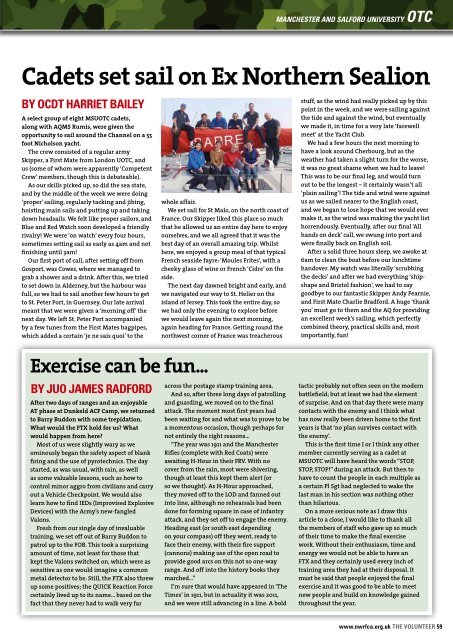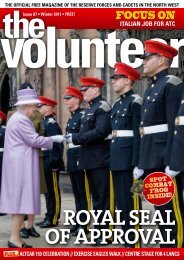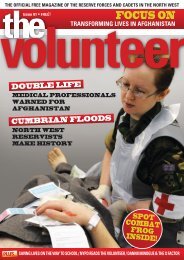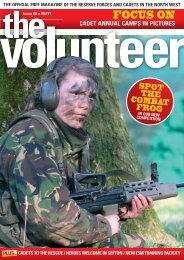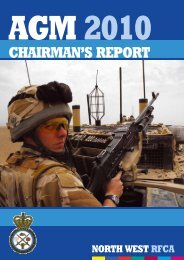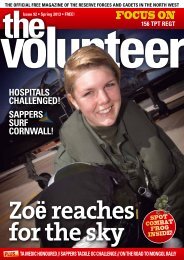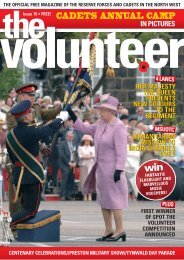Issue 87 - NWRFCA - Northwest Reserve Forces & Cadets Association
Issue 87 - NWRFCA - Northwest Reserve Forces & Cadets Association
Issue 87 - NWRFCA - Northwest Reserve Forces & Cadets Association
You also want an ePaper? Increase the reach of your titles
YUMPU automatically turns print PDFs into web optimized ePapers that Google loves.
manchester and salford university<br />
Otc<br />
<strong>Cadets</strong> set sail on Ex Northern Sealion<br />
by OCdt Harriet Bailey<br />
A select group of eight MSUOTC cadets,<br />
along with AQMS Rumis, were given the<br />
opportunity to sail around the Channel on a 55<br />
foot Nicholson yacht.<br />
The crew consisted of a regular army<br />
Skipper, a First Mate from London UOTC, and<br />
us (some of whom were apparently ‘Competent<br />
Crew’ members, though this is debateable).<br />
As our skills picked up, so did the sea state,<br />
and by the middle of the week we were doing<br />
‘proper’ sailing, regularly tacking and jibing,<br />
hoisting main sails and putting up and taking<br />
down headsails. We felt like proper sailors, and<br />
Blue and Red Watch soon developed a friendly<br />
rivalry! We were ‘on watch’ every four hours,<br />
sometimes setting sail as early as 4am and not<br />
finishing until 3am!<br />
Our first port of call, after setting off from<br />
Gosport, was Cowes, where we managed to<br />
grab a shower and a drink. After this, we tried<br />
to set down in Alderney, but the harbour was<br />
full, so we had to sail another few hours to get<br />
to St. Peter Port, in Guernsey. Our late arrival<br />
meant that we were given a ‘morning off’ the<br />
next day. We left St. Peter Port accompanied<br />
by a few tunes from the First Mates bagpipes,<br />
which added a certain ‘je ne sais quoi’ to the<br />
whole affair.<br />
We set sail for St Malo, on the north coast of<br />
France. Our Skipper liked this place so much<br />
that he allowed us an entire day here to enjoy<br />
ourselves, and we all agreed that it was the<br />
best day of an overall amazing trip. Whilst<br />
here, we enjoyed a group meal of that typical<br />
French seaside fayre: ‘Moules Frites’, with a<br />
cheeky glass of wine or French ‘Cidre’ on the<br />
side.<br />
The next day dawned bright and early, and<br />
we navigated our way to St. Helier on the<br />
island of Jersey. This took the entire day, so<br />
we had only the evening to explore before<br />
we would leave again the next morning,<br />
again heading for France. Getting round the<br />
northwest corner of France was treacherous<br />
stuff, as the wind had really picked up by this<br />
point in the week, and we were sailing against<br />
the tide and against the wind, but eventually<br />
we made it, in time for a very late ‘farewell<br />
meet’ at the Yacht Club.<br />
We had a few hours the next morning to<br />
have a look around Cherbourg, but as the<br />
weather had taken a slight turn for the worse,<br />
it was no great shame when we had to leave!<br />
This was to be our final leg, and would turn<br />
out to be the longest – it certainly wasn’t all<br />
‘plain sailing’! The tide and wind were against<br />
us as we sailed nearer to the English coast,<br />
and we began to lose hope that we would ever<br />
make it, as the wind was making the yacht list<br />
horrendously. Eventually, after our final ‘All<br />
hands on deck’ call, we swung into port and<br />
were finally back on English soil.<br />
After a solid three hours sleep, we awoke at<br />
6am to clean the boat before our lunchtime<br />
handover. My watch was literally ‘scrubbing<br />
the decks’ and after we had everything ‘shipshape<br />
and Bristol fashion’, we had to say<br />
goodbye to our fantastic Skipper Andy Fearnie,<br />
and First Mate Charlie Bradford. A huge ‘thank<br />
you’ must go to them and the AQ for providing<br />
an excellent week’s sailing, which perfectly<br />
combined theory, practical skills and, most<br />
importantly, fun!<br />
Exercise can be fun...<br />
by JUO James Radford<br />
After two days of ranges and an enjoyable<br />
AT phase at Dunkeld ACF Camp, we returned<br />
to Barry Buddon with some trepidation.<br />
What would the FTX hold for us? What<br />
would happen from here?<br />
Most of us were slightly wary as we<br />
ominously began the safety aspect of blank<br />
firing and the use of pyrotechnics. The day<br />
started, as was usual, with rain, as well<br />
as some valuable lessons, such as how to<br />
control minor aggro from civilians and carry<br />
out a Vehicle Checkpoint. We would also<br />
learn how to find IEDs (Improvised Explosive<br />
Devices) with the Army’s new-fangled<br />
Valons.<br />
Fresh from our single day of invaluable<br />
training, we set off out of Barry Buddon to<br />
patrol up to the FOB. This took a surprising<br />
amount of time, not least for those that<br />
kept the Valons switched on, which were as<br />
sensitive as one would imagine a common<br />
metal detector to be. Still, the FTX also threw<br />
up some positives; the QUICK Reaction Force<br />
certainly lived up to its name... based on the<br />
fact that they never had to walk very far<br />
across the postage stamp training area.<br />
And so, after three long days of patrolling<br />
and guarding, we moved on to the final<br />
attack. The moment most first years had<br />
been waiting for and what was to prove to be<br />
a momentous occasion, though perhaps for<br />
not entirely the right reasons...<br />
“The year was 1911 and the Manchester<br />
Rifles (complete with Red Coats) were<br />
awaiting H-Hour in their FRV. With no<br />
cover from the rain, most were shivering,<br />
though at least this kept them alert (or<br />
so we thought). As H-Hour approached,<br />
they moved off to the LOD and fanned out<br />
into line, although no rehearsals had been<br />
done for forming square in case of infantry<br />
attack, and they set off to engage the enemy.<br />
Heading east (or south east depending<br />
on your compass) off they went, ready to<br />
face their enemy, with their fire support<br />
(cannons) making use of the open road to<br />
provide good arcs on this not so one-way<br />
range. And off into the history books they<br />
marched...”<br />
I’m sure that would have appeared in ‘The<br />
Times’ in 1911, but in actuality it was 2011,<br />
and we were still advancing in a line. A bold<br />
tactic probably not often seen on the modern<br />
battlefield; but at least we had the element<br />
of surprise. And on that day there were many<br />
contacts with the enemy and I think what<br />
has now really been driven home to the first<br />
years is that ‘no plan survives contact with<br />
the enemy’.<br />
This is the first time I or I think any other<br />
member currently serving as a cadet at<br />
MSUOTC will have heard the words “STOP,<br />
STOP, STOP!” during an attack. But then to<br />
have to count the people in each multiple as<br />
a certain Pl Sgt had neglected to wake the<br />
last man in his section was nothing other<br />
than hilarious.<br />
On a more serious note as I draw this<br />
article to a close, I would like to thank all<br />
the members of staff who gave up so much<br />
of their time to make the final exercise<br />
work. Without their enthusiasm, time and<br />
energy we would not be able to have an<br />
FTX and they certainly used every inch of<br />
training area they had at their disposal. It<br />
must be said that people enjoyed the final<br />
exercise and it was good to be able to meet<br />
new people and build on knowledge gained<br />
throughout the year.<br />
www.nwrfca.org.uk the volunteer 59


